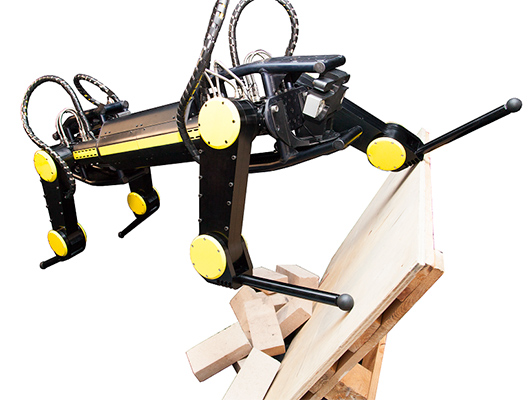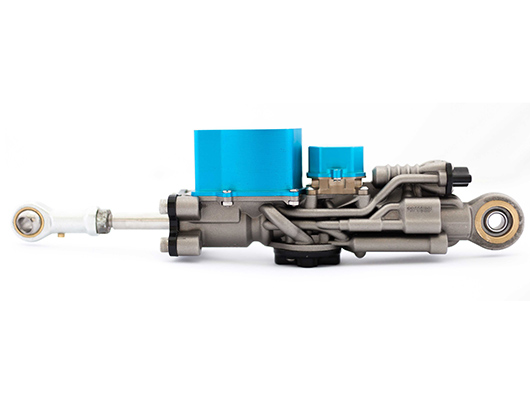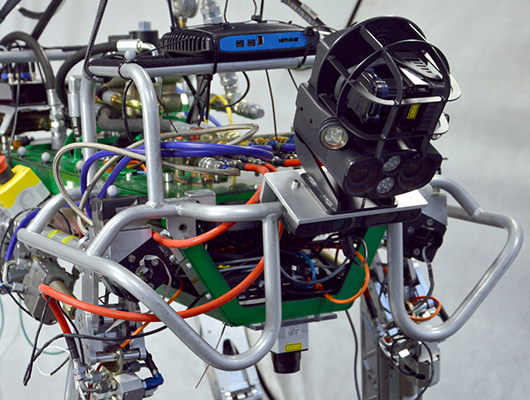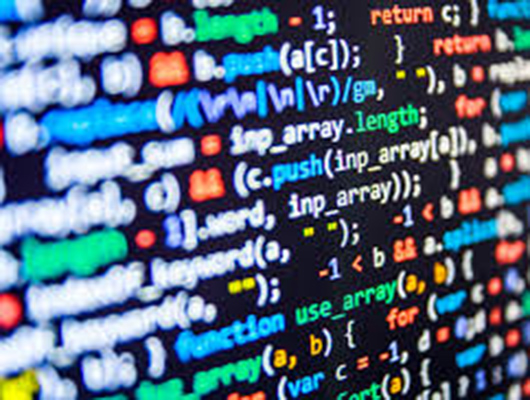The Dynamic Legged Systems lab focuses on research that concerns the design and control aspects of legged robots. We are interested in the design and development of legged robotic systems, chiefly quadrupeds, and we are investigating ways that can increase flexibility and performance of legged designs. Apart from developing quadrupedal robots we emphasize the need for accurate and robust control, ranging from the level of individual joints, often in hardware, up to the overall behavior of the legged robot. Apart from accurate hydraulic force/torque control at the joint level we are investigating ways of creating and using a variety of different locomotion gaits, that are robust to external disturbances and changing environmental conditions. A significant part of our groups' effort is devoted to perception tailored to dynamic quadrupedal robots.
Robot Design and Development

A key expertise of the DLS lab is the design, development and construction of hydraulic quadruped robots. The lab has built several prototypes: HyQ (2010), HyQ2Max (2015), MiniHyQ (2015), and HyQReal (2019). The first leg prototype was built and tested in 2008. All quadrupeds in the HyQ series have 12 active degrees of freedom that are driven by hydraulic actuators. The legs, torso and actuators are mainly made out of aerospace-grade aluminum, stainless steel, and titanium. The protective skin and feet are made of kevlar-glass fiber panels and rubber, respectively. Since 2012 the lab has been investigating the use of metal Additive Manufacturing (AM) to improve the hydraulic components and robot design in general. The Moog@iit joint lab was inaugurated in 2016 with the goal to develop the next generation hydraulic quadruped. Moog has developed the Integrated Servo Actuator (ISA) that has a 3D printed body in titanium. HyQReal is the result of IIT and Moog's fruitful collaboration.
Locomotion

The main ingredients for legged locomotion are planning, control, perception and state estimation. in our locomotion framework, we envisioned different layers, according to the quality of the perception feedback available. At the bottom layer we have blind reactive strategies, with basic terrain adaptation mechanisms and reflex strategies. Motion primitives are triggered to override the planner in situations where the robot could be damaged (e.g. stumbling). We also implemented several gaits (crawl, trot and bounding) that allow our quadruped robots traverse challenging terrains. However, when the complexity of the terrain to be negotiated increases, or when the execution of the requested task involves highly dynamic motions, optimization-based planning strategies are preferable. Therefore, another branch of studies is aiming to reduce the complexity of the optimization, trading off accuracy with computational efficiency, in order to be able to carry out (online) optimization of trajectories during locomotion.
Hydraulic Control

Hydraulics is a mechanical function that operates through the force of liquid pressure. Hydraulic systems use fluids at high pressure to achieve mechanical movement, resulting in a force or torque. The pressure is due to the incompressibility of hydraulic fluid, which enables greater power transfer with increased efficiency, as energy is not lost to compression. In hydraulic power systems, there are several main components: - a reservoir, a drive system, hydraulic pump, control valves, actuator and load. The use of hydraulics, within the robotics sector benefits significantly with the addition of the electrohydraulic servo valve. In a typical servo valve, the valve receives an electrical input signal, which is converted to a hydraulic pressure. The servo valve then applies the hydraulic pressure to an actuator. The pressure is proportional to the electrical signal. In feedback control systems, this allows very accurate control of parameters such as position, force and velocity. These signals are measured and sent to a controller, which in turn varies the electrical signal to the servo valve.
Perception

The perception group research focuses on developing the sensing on the quadruped robot HyQ in order to make the robot more autonomous. The Dynamic Legged Systems Lab (DLS) is currently working on the implementation of state estimation and computer vision algorithms for a range of diverse applications for quadruped robots. Some examples include hetrogeneous sensor fusion for accurate state estimation, probabilistic foot contact estimation, SLAM, visual servoing, automatic sensor calibration, stair climbing and terrain mapping. Autonomous legged robots are required to handle a wide range of tasks in complex environments. Current computer vision algorithms are not robust in dynamic environments, however, using computer vision is critical to improving autonomy. It is well-known that video images provide rich information about the environment which is critical for localization in environments without a priori maps. For example, such uncertainty in environment would be expected in monitoring a disaster scene.
Robotic Software

Research and development of software for robotics at the Dynamic Legged Systems lab includes software for hard real-time control and communication, software for kinematics and dynamics of articulated robots, and software architectures for autonomous legged machines based on the Robotic Operating System (ROS). Our work includes development of robotic software both for simulations and real robotic platforms.